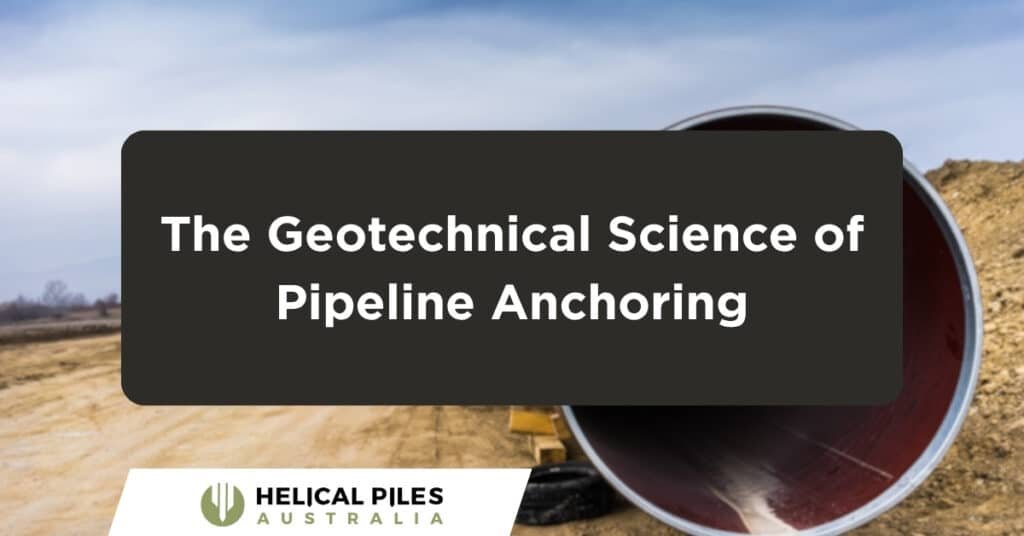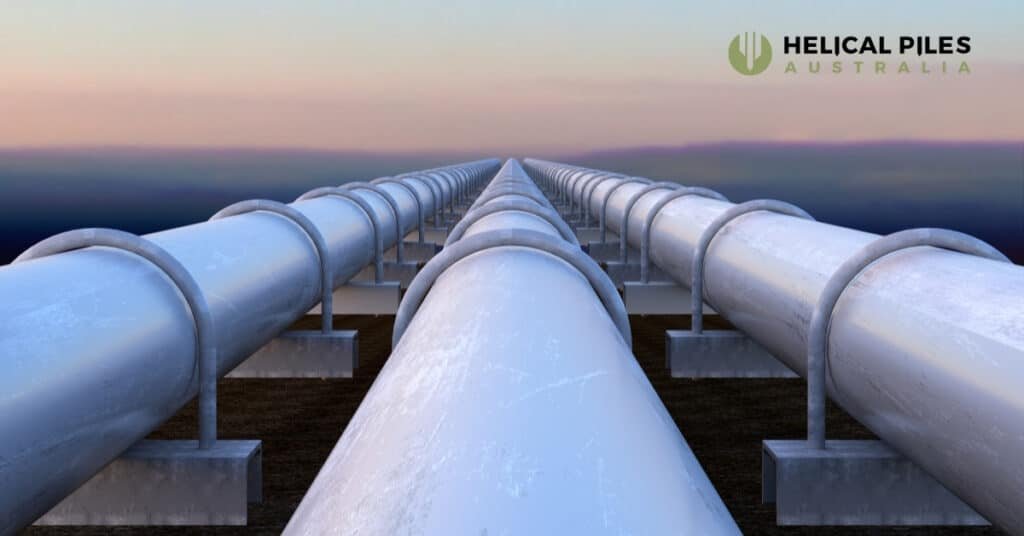ARTICLE
The Geotechnical Science of Pipeline Anchoring: Understanding Soil Mechanics and Helical Piles

Summary
- Pipeline anchoring is fundamental for ensuring long-term pipeline stability geotechnical engineering.
- Soil mechanics for pipeline design dictates the forces and risks a pipeline will face.
- Buoyancy control for pipelines is a primary challenge in many Australian environments.
- Helical piles for pipelines present a versatile and efficient anchoring solution.
- Design must comply with Australian pipeline standards AS 2885 and AS 2159.
- A thorough geotechnical investigation for pipelines is the first step to a successful project.
Australia’s vast geography is connected by an extensive network of pipelines, transporting essential resources like water, gas, and mineral slurries. The integrity of this infrastructure is paramount.
The core challenge in any pipeline project is securing these assets against powerful geotechnical and environmental forces. Pipeline anchoring is not just about holding a pipe down; it is a specialised field of engineering that ensures long-term operational safety and reliability.
This article explores the geotechnical science of pipeline anchoring, focusing on the foundational principles of soil mechanics and the application of modern helical piles as a superior anchoring solution in the demanding Australian landscape.
The Role of Soil Mechanics in Pipeline Design
The ground beneath a pipeline is an active engineering material, not merely a passive trench. Its properties and behaviour directly influence the forces exerted on the pipeline throughout its service life.
A foundational understanding of soil mechanics for pipeline design is therefore essential for any engineer tasked with ensuring pipeline integrity management.
Key Soil Properties and Their Influence
Effective anchoring design begins with characterising the soil’s engineering properties. Key soil strength parameters include cohesion (the internal bond of clay particles), friction angle (the resistance to sliding in sandy soils), and overall density.
In Australia, engineers frequently encounter challenging soil types, from the highly reactive clays of the eastern states that swell and shrink with moisture changes, to the loose, non-cohesive sands found in coastal and arid regions.
Each soil type presents a unique set of challenges for pipeline foundation design, influencing everything from trench stability to the uplift resistance of an anchor.
Understanding Soil-Pipe Interaction Modelling
A pipeline and the surrounding soil exist in a state of continuous interaction. The pipe exerts pressure on the soil, and the soil resists movement through friction and passive pressure. Soil-pipe interaction modelling uses sophisticated software to simulate these complex forces.
By inputting data from a geotechnical investigation for pipelines, engineers can predict how the pipe will behave under various load conditions.
This analysis helps identify potential hotspots for stress distribution and determines the optimal spacing and capacity requirements for the chosen pipeline anchoring solutions Australia.

Geotechnical Risks and Forces Affecting Pipeline Stability
Pipelines face a variety of threats that can compromise their structural integrity. These geotechnical risks in pipeline construction must be identified and mitigated through robust engineering design and anchoring.
Pipeline Flotation Prevention and Buoyancy Control
One of the most significant risks is buoyancy. In areas with high groundwater tables, in floodplains, or at river crossings, the upward force of the displaced water can exceed the downward weight of the pipe, causing it to lift out of the trench.
This leads to buckling, joint failure, and catastrophic rupture. Effective buoyancy control for pipelines is therefore a primary design consideration, requiring anchoring systems that provide predictable and sufficient pipeline uplift resistance.
Ground Movement Pipeline Protection
Australia’s geology presents unique challenges for ground movement pipeline protection. Expansive soils can exert immense pressure as they change volume with moisture cycles. In mining regions, subsidence can cause differential settlement that puts extreme strain on a pipeline.
While major seismic events are less frequent than in other parts of the world, even minor tremors can induce ground movements that must be accounted for. Anchors help manage these stresses by restraining the pipe in stable ground.
Managing Lateral Pipe Movement and Thermal Expansion
Pipelines are also subject to lateral, or sideways, forces. Temperature fluctuations cause long sections of steel pipe to expand and contract, which can lead to lateral pipe movement if not properly restrained.
On sloped terrain, inadequate slope stability can cause the ground to shift, pushing the pipeline with it. At river or marine crossings, hydrodynamic forces from currents add another layer of complexity. Anchoring systems must be designed to resist these lateral loads to maintain the pipeline’s alignment and prevent fatigue.
The Engineering Advantages of Helical Piles Pipeline Support
The adoption of helical piles for pipelines is driven by a clear set of engineering and project advantages. Their installation is remarkably fast, often taking just minutes per pile, and they can be loaded immediately. This eliminates the project delays associated with waiting for concrete to cure, accelerating construction schedules.
The helical anchor installation Australia process requires smaller equipment, such as an excavator fitted with a hydraulic torque head, which minimises the environmental footprint. This is a significant benefit in sensitive ecosystems or agricultural lands. There is no spoil to remove from the site, and minimal ground disturbance occurs.
Perhaps the most important advantage is the verifiability of the anchor’s capacity. During installation, the hydraulic pressure and rotation speed are measured to calculate the applied torque.
This installation torque has a direct empirical correlation to the pile’s ultimate capacity, providing real-time quality assurance for every anchor installed. This level of certainty is difficult to achieve with traditional methods. Their performance across a wide range of site-specific conditions makes them a versatile and reliable choice for pipeline foundation design.
Pipeline Geotechnical Design Guidelines for Helical Piles
The design of a helical pile anchoring system is a precise process governed by established geotechnical design guidelines and Australian standards.
The Criticality of Geotechnical Investigation for Pipelines
No anchor design can proceed without reliable data. A comprehensive geotechnical investigation for pipelines is the first and most important step. This involves drilling boreholes, conducting cone penetration tests (CPTs), and performing laboratory analysis of soil samples.
The resulting data provides the soil strength parameters needed to accurately model the site-specific conditions and engineer the helical pile solution, including the required depth, shaft size, and helix plate configuration.
Calculating Pipeline Uplift Resistance and Bearing Capacity
The primary function of a pipeline anchor is to provide pipeline uplift resistance. The capacity of a helical pile is calculated based on engineering principles that consider the bearing area of each helix plate and the shear strength of the surrounding soil.
The direct relationship between installation torque and capacity is a key element of the design and verification process.
| Soil Type | Installation Torque (Nm) | Estimated Ultimate Uplift Capacity (kN) |
|---|---|---|
| Loose Sand | 5,000 | ~100 |
| Medium Dense Sand | 10,000 | ~180 |
| Stiff Clay | 8,000 | ~150 |
| Very Stiff Clay | 15,000 | ~250 |
This relationship can be visualised in a graph plotting installation torque against pile capacity.
As torque increases with depth and soil density, the engineer can confirm the pile has reached the required stratum and achieved its design capacity, providing a high degree of confidence in the final installation.
Adherence to Australian Pipeline Codes and Standards
All pipeline anchoring solutions Australia must comply with national standards. Two key documents are:
- Australian pipeline standards AS 2885 (Pipelines – Gas and Liquid Petroleum): This standard outlines the mandatory requirements for designing pipelines to be safe and stable against all foreseeable loads, including buoyancy and ground movement.
- AS 2159 (Piling – Design and Installation): This standard provides the technical guidelines for designing and installing all types of piles, including helical piles, ensuring appropriate safety factors and design methodologies are used.
Helical Anchor Installation and Quality Assurance
The installation process for helical anchors is systematic and efficient, with quality control integrated at every step.
The Installation Process
- The installation equipment, typically an excavator or large skid steer with a hydraulic torque head, is positioned over the anchor location.
- The lead section of the helical pile is attached to the torque head.
- The operator applies controlled downward pressure (crowd) and rotation, screwing the pile into the ground.
- The operator continuously monitors the installation torque and depth on a digital gauge.
- If required, extension shafts are added to advance the pile until the design depth or target installation torque is achieved.
- Finally, a specially designed pipeline connection bracket is attached to the top of the pile shaft.
Quality Control and Load Testing
As mentioned, the primary quality control method is monitoring and recording the final installation torque for every pile. This provides an immediate and reliable indication of its ultimate capacity.
For exceptionally critical applications or to validate a design in unique soil conditions, a physical tension load testing program may be performed on a sacrificial or production pile to confirm its performance under real-world loads.
On The Geotechnical Science of Pipeline Anchoring
The long-term stability of Australia’s essential pipeline infrastructure is a direct result of applying sound geotechnical science. Understanding the complex interactions between a pipeline and the ground is the basis for effective anchoring design that mitigates risks like buoyancy and ground movement.
Modern solutions like helical piles offer engineers a technically superior, efficient, and verifiable tool for these challenges. By combining thorough investigation with proven technology, we can ensure the integrity and safety of these vital assets for decades to come.
Frequently Asked Questions About The Geotechnical Science of Pipeline Anchoring
What Are The Methods Of Anchoring Pipelines?
Primary methods include traditional concrete gravity anchors (saddle weights or deadman blocks) that rely on mass, and engineered deep foundations. The most modern and versatile deep foundation method is helical piles (or screw piles), which are screwed into the ground to provide exceptional tension and compression capacity.
Why Do We Need To Anchor Pipelines?
Pipelines require anchoring to resist various forces that can cause movement and lead to failure. This includes counteracting buoyancy (uplift forces) in wet conditions, restraining the pipe against thermal expansion and contraction, and protecting it from the effects of ground movement, slope stability issues, or soil erosion.
How Does Soil Uplift Affect Pipelines?
Soil uplift, primarily caused by buoyant forces from groundwater, can lift a pipeline out of its trench if the upward force is greater than the pipe’s weight. This can cause the pipe to buckle, bend excessively, and place extreme stress on welded joints, potentially leading to leaks or a complete rupture.
What Is The Purpose Of Helical Piles?
The purpose of helical piles is to function as a deep foundation system. In pipeline applications, they are used primarily as tension anchors to provide uplift resistance against buoyancy. They transfer these uplift loads from the pipeline through their steel shaft and helical plates into deeper, more stable soil layers that have the capacity to resist the load.
How Do You Calculate Soil Uplift Resistance?
Soil uplift resistance for a helical pile is calculated based on geotechnical engineering principles. The design typically uses the individual bearing method, where the capacity is the sum of the bearing resistance on each helix plate. This theoretical capacity is then verified in the field using the direct correlation between the installation torque required to install the pile and its ultimate holding capacity.
What Is Soil Anchoring In Geotechnical Engineering?
Soil anchoring is a geotechnical technique used to transfer a tension or uplift load from a structure to a competent soil or rock stratum. An anchor, such as a helical pile or a grouted rock anchor, is installed into the ground to a depth where the soil is strong enough to resist the pulling force, thereby stabilising the structure at the surface.
Need a quote or more info? Start here.
Contact Us
info@helicalpilesaustralia.com.au
+61 2 7251 9258
Mon–Fri, 8:00am–5:00pm AEST

Built for complexity.
Engineered for certainty.
A trusted partner for large-scale energy and infrastructure projects where precision isn’t optional, it’s mandatory
© 2025 Helical Piles Australia. All rights reserved.
Privacy Policy
Contact Us
info@helicalpilesaustralia.com.au
+61 2 7251 9258
Mon – Fri, 8:00am – 5:00pm AEST
Location
Ground Floor 3, 189 Kent St
Sydney, NSW 2000

